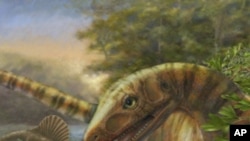Scientists have announced the discovery a relative of dinosaurs that lived ten million years earlier than the oldest known dinosaurs. Paleontologists say the creature will improve their understanding of prehistoric animals.
The fossils of Asilisaurus kongwe were recovered by paleontologists in a large bone bed in Tanzania in 2003.
The creature, which shared many characteristics of dinosaurs but lacked many key features, lived 240-million years ago in the middle Triassic period before any known dinosaur. The earliest dinosaur fossils date back 230-million years.
Scientists say Asilisaurus was approximately the size of a dog, about one to three meters long weighing ten to thirty kilograms. It also walked on four legs.
Sterling Nesbitt, a geoscientist at the University of Texas in Austin, led the team of excavators. Nesbitt says Asilisaurus ate a variety of plants and some meat. "They have adaptations that suggest it ate plants in the mouth, such as these peg-like teeth and a very short little beak on the lower jaw," he explained.
Paleontologists unearthed the bones of at least fourteen mostly young Asilisaurs that all died at the same time, and scientists had enough fossils to assemble a nearly complete animal.
Experts say the existence of Asilisaurus ten million years before the earliest known dinosaurs suggests dinosaurs had already begun to diverge from common ancestors into separate lineages 240 million ago.
Nesbitt says several distinct groups of dinosaurs sprung from Asilisaurus, including plant-eating silesaurs, flying dinosaurs known as pterosaurs and several groups of ancient crocodile relatives, some of which were also found in the bone bed along with Asilisauris.
The relationship between Asilisaurus and the dinosaurs, according to Nesbitt, is similar to the relationship of chimps to humans. "To find something that's one of the closest relatives to dinosaurs really helps our understanding of the divergence of dinosaur-like animals and even dinosaurian," he said.
An article describing Asilisaurus kongwe is published this week in journal Nature.
Scientists Discover Earliest Known Dinosaur Relative






